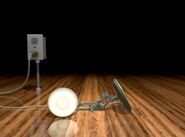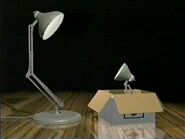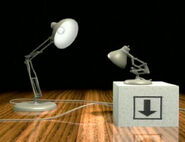(→Plot) |
Pixarfandom (talk | contribs) (We don't really need a video of it, a trailer is enough) |
||
| Line 8: | Line 8: | ||
==Plot== |
==Plot== |
||
| − | [[Video:Luxo Jr - Pixar|thumb|right|300px|The Short]] |
||
| − | |||
The only characters are two [http://en.wikipedia.org/wiki/Anglepoise_lamp Anglepoise] desk lamps, inspired by a Luxo brand task-light on [[John Lasseter|John Lasseter's]] desk. The small lamp, [[Luxo, Jr. (character)|Luxo, Jr.]] plays with a small inflated rubber [[Ball|ball]], chasing it and trying to balance on it as Luxo, [[Luxo, Sr.|the larger lamp]] reacts to these antics. The ball eventually deflates due to Luxo Jr. jumping on it. Luxo Jr. is admonished by Luxo, then finds and plays with an even larger ball.<ref>Lasseter, J. (1987) cited in Mealing, S. (1998). ''The Art and Science of Computer Animation.'' Intellect Books. ISBN 978-1871516715.</ref> |
The only characters are two [http://en.wikipedia.org/wiki/Anglepoise_lamp Anglepoise] desk lamps, inspired by a Luxo brand task-light on [[John Lasseter|John Lasseter's]] desk. The small lamp, [[Luxo, Jr. (character)|Luxo, Jr.]] plays with a small inflated rubber [[Ball|ball]], chasing it and trying to balance on it as Luxo, [[Luxo, Sr.|the larger lamp]] reacts to these antics. The ball eventually deflates due to Luxo Jr. jumping on it. Luxo Jr. is admonished by Luxo, then finds and plays with an even larger ball.<ref>Lasseter, J. (1987) cited in Mealing, S. (1998). ''The Art and Science of Computer Animation.'' Intellect Books. ISBN 978-1871516715.</ref> |
||
Revision as of 07:07, 22 May 2011
- See also: Luxo, Jr. (character)
- "In 1986 Pixar produced its first film. This is why we have a hopping lamp in our logo."
- —Pretext
Luxo, Jr. was the first film produced by the newly formed Pixar company. The story of a child Luxo lamp and its parent, it debuted at the 1986 SIGGRAPH conference in Dallas, Texas.
The short was re-issued in 1999 and shown before screenings of Toy Story 2.
Plot
The only characters are two Anglepoise desk lamps, inspired by a Luxo brand task-light on John Lasseter's desk. The small lamp, Luxo, Jr. plays with a small inflated rubber ball, chasing it and trying to balance on it as Luxo, the larger lamp reacts to these antics. The ball eventually deflates due to Luxo Jr. jumping on it. Luxo Jr. is admonished by Luxo, then finds and plays with an even larger ball.[1]
Significance
On the technical level, the film demonstrates the use of shadow maps to simulate the shifting light and shadow given by the animated lamps.[2] The lights and the color surfaces of all the objects are calculated, each using a RenderMan surface shader, not surface textures.[2] The articulation of "limbs" is carefully coordinated, and power cords trail believably behind the moving lamps.[2] On the cinematic level, it demonstrates a simple and entertaining story, including effectively expressive individual characters.[3]
It was Pixar's first animation after Ed Catmull and John Lasseter left ILM's computer division. Lasseter's aim was to finish the short film for SIGGRAPH, an annual computer technology exhibition attended by thousands of industry professionals. Catmull and Lasseter worked around the clock, and Lasseter even took a sleeping bag into work and slept under his desk[4], ready to work early the next morning. The commitment paid off, and against all odds it was finished for SIGGRAPH. Before Luxo Jr. finished playing at SIGGRAPH, the crowd had already risen in applause.[5]
"Luxo Jr. sent shock waves through the entire industry – to all corners of computer and traditional animation. At that time, most traditional artists were afraid of the computer. They did not realize that the computer was merely a different tool in the artist's kit but instead perceived it as a type of automation that might endanger their jobs. Luckily, this attitude changed dramatically in the early '80s with the use of personal computers in the home. The release of our Luxo Jr. ... reinforced this opinion turnaround within the professional community.” –Edwin Catmull, Computer Animation: A Whole New World, 1998.
In 1986, Luxo Jr. received an Academy Award nomination for Best Animated Short Film. It was the first computer animated film to be nominated for an Academy Award.[6]
In To Infinity and Beyond!: The Story of Pixar Animation Studios, a book of Pixar's history up through January 2007, film critic Leonard Maltin said that he "like[s] the fact that Luxo [Jr.] still has significance to the people at Pixar", and remarked that it was something like Disney's Mickey Mouse.
Credits
- Director: John Lasseter
- Producer: John Lasseter, Bill Reeves
- Writer: John Lasseter
- Music: Chick Corea
Other appearances
- Luxo, Jr. (sans cord) is seen in the opening logo of each Pixar film (standing in for the "i" in "Pixar").
- Since the short's release, the Ball has appeared in almost every Pixar production to date.
- There is a scene in Toy Story 2 where the toys frantically flick through TV channels to find a certain commercial. One of the channels is showing Luxo Jr.* An audio-animatronic version of Luxo Jr. appears in Pixar Place at Disney's Hollywood Studios theme park. It comes out of shutters on the side of a building, bouncing out onto a platform. It dances around to different music that plays during the day, and at night it interacts with the lighting in nearby trees.
- A series of four shorts featuring Luxo, Jr and his father were produced for Sesame Street and aired in 1991.
Gallery
References
- ↑ Lasseter, J. (1987) cited in Mealing, S. (1998). The Art and Science of Computer Animation. Intellect Books. ISBN 978-1871516715.
- ↑ 2.0 2.1 2.2 Foley, J. D., Van Dam, A., Feiner, S. K. & Hughes, J. F. (1995). Computer Graphics: Principles and Practice. Addison-Wesley. ISBN 978-0201848403.
- ↑ Courrier, K. (2005). Randy Newman's American Dreams: American Dreams. ECW Press. ISBN 978-1550226904.
- ↑ The Pixar Story (2007) (TV documentary)
- ↑ Paik, K., Lasseter, J., Iwerks, L., Jobs, S. & Catmull, E. (2007). To Infinity and Beyond!: The Story of Pixar Animation Studios. Chronicle Books. ISBN 978-0811850124.
- ↑ Paik, Karen (2007). To Infinity and Beyond! The Story of Pixar Animation Studios. San Francisco, CA: Chronicle Books LLC.
External links
- Pixar's official Luxo Jr. site (Downloadable movie available)
- The Love of Two Desk Lamps





